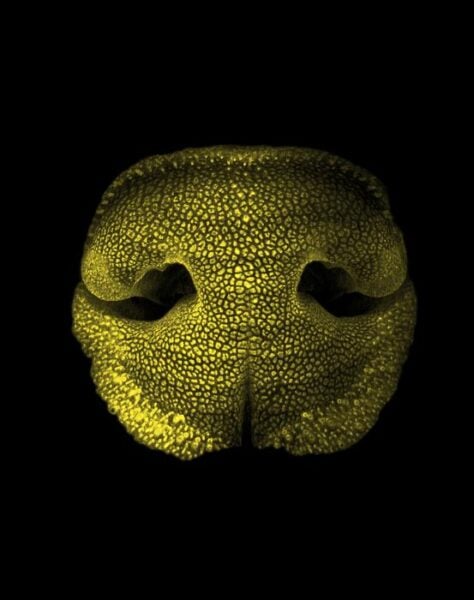Researchers have uncovered the precise physical process that creates the unique grooved patterns on the noses of dogs, ferrets, cows and other mammals. The findings provide new insights into how complex biological structures form during development.
Summary: New research reveals the physical mechanisms behind the distinctive polygonal patterns found on the noses of many mammals. The study shows these patterns emerge through mechanical forces during embryonic development, with blood vessels playing a crucial structural role.
Reading time: 4 minutes
The Architecture of Animal Noses
“Finding specific examples of beautiful patterns in living organisms is easy. All we have to do is look around us! Our latest study focuses on the noses of dogs, ferrets and cows, which exhibit a singular network of polygonal structures,” explains Michel Milinkovitch from the University of Geneva’s Department of Genetics and Evolution.
These polygonal structures serve important functions. By retaining moisture, the grooves keep the nose wet and help collect pheromones and odor molecules. The research team used advanced 3D imaging techniques to examine how these patterns develop in embryos.
A Mechanical Process
Using “light sheet fluorescence microscopy”, which enables three-dimensional visualization of biological structures, the researchers discovered that these patterns form through mechanical forces during development. As different skin layers grow at different rates, the outer layer forms domes supported by underlying blood vessels.
“Our numerical simulations show that the mechanical stress generated by excessive epidermal growth is concentrated at the positions of the underlying vessels, which form rigid support points. The epidermal layers are then pushed outwards, forming domes – akin to arches rising against stiff pillars,” says Paule Dagenais, post-doctoral fellow at the University of Geneva.
Glossary of Terms
- Epidermis: The outer layer of skin
- Mechanical stress: Forces acting on tissues during growth
- Morphogenesis: The biological process of tissue and organ formation
- Fluorescence microscopy: Imaging technique using fluorescent markers
- Polygonal: Having multiple sides and angles
- Embryogenesis: The process of embryo development
Quick Quiz
- What is the main function of nose grooves in mammals?
- How do the patterns form during development?
- What role do blood vessels play in the pattern formation?
Answers:
- They retain moisture to keep the nose wet and help collect odor molecules
- Through mechanical forces as different skin layers grow at different rates
- They act as rigid support points that help shape the pattern of domes and grooves
Enjoy this story? Get our newsletter! https://scienceblog.substack.com/
Further reading: DOI: 10.1016/j.cub.2024.09.055
If our reporting has informed or inspired you, please consider making a donation. Every contribution, no matter the size, empowers us to continue delivering accurate, engaging, and trustworthy science and medical news. Independent journalism requires time, effort, and resources—your support ensures we can keep uncovering the stories that matter most to you.
Join us in making knowledge accessible and impactful. Thank you for standing with us!

